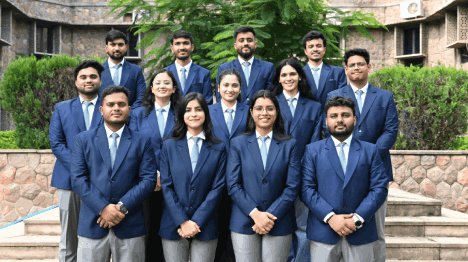- About Us
- Academics
Schools
Programs
General Information
- Faculty
The faculty members and researchers working at IIHMR University come from varied backgrounds including, but not limited to medicine, public health, management, economics, statistics, demography, human geography, social and behavioral sciences, rural development and pharmaceuticals.
- Admissions
- Research
.Publications & Journal
- Executive Education
Executive Programmes
- Online Certification Courses
ONLINE CERTIFICATION Courses
- Training
- Placements
- Fee Payment
- NAAC
- IQAC
- NIRF
- Webinars
- About Us
- About IIHMR University
- Board of Management
- Academic Council
- Board of Studies
- Research Board
- Institutional Review Board
- Finance & Audit Committee
- Departmental Research Committee
- Chairperson's Message
- President's Message
- IIHMR University Act
- Infrastructure
- Collaboration
- Ranking
- Board of Studies (School of Digital Health)
- Awards & Accolades
- Academics
- Institute of Health Management Research
- School of Pharmaceutical Management
- School of Development Studies
- School of Digital Health
- SD Gupta School of Public Health
- MBA (Hospital and Health Management)
- MBA (Pharmaceutical Management)
- MBA (Development Management)
- MBA (Healthcare Analytics)
- Master of Public Health
- Student Manual – Cohort 9 (2021-2023)
- Master of Public Health (Cooperative programme with Johns Hopkins University)
- Ph. D.
- MBA CSR & ESG Management (Executive)
- MBA Sustainable Business Management (Executive)
- Common Information for all the Programs
- Academic Calendar
- Student Handbook 2020-21
- Committees
- Policies
- Annual Exam Calendar
- Library
- Faculty
- Officers of University
- Dean of Institute of Health Management Research
- Dean of School of Pharmaceutical Management
- Dean of School of Development Studies
- Dean of SD Gupta School of Public Health
- Dean of School of Digital Health
- School of Digital Health
- Faculty List A to Z
- Faculty List Designation Wise
- Faculty List School Wise
- Admissions
- Research
- Executive Education
- Training
- Placements
- Alumni
- Events
- Job Openings
- Contact
- Research
Data analysis and reporting on Sanitation, ICDS, Public Health & other Issue under Nadia District
Agency : Zila Parishad, Nadia Kolkata
The Zilla Parishad, Nadia has conducted a census to identify the gap areas for further improvement in areas like public health, water, sanitation and hygiene (WASH) covering child, adolescents and mother. The Census collected household specific information on family size and its composition (by sex, age, disability status), primary occupation, health seeking behavior of pregnant women and her infants in the household in the last one year, information on mother and infant death if any, utilization of Anganwadi centers (AWC), sources of drinking water and sanitation practices followed in the family including their solid and liquid waste management habits. This study used quantitative methods to explore the present maternal, newborn and child health & nutrition practices among the households of Nadia district. It was important to assess and identify the gap to have evidence informed strategies for further improvement of health care seeking behavior and nutritional practices among newborn child, lactating mother and pregnant women along with WASH and waste management behavior of the households in general.
In terms of WASH, the district has achieved a lot including the status of first open defecation free district of West Bengal. Now it is high time to keep the status intact. Although in majority of households tube well remains the major sources of drinking water, point of concern is the 2.93 percent households who still access drinking water from open sources. Similarly, in terms of sanitary latrine majority are using single pit latrine, so this can be upgraded to double pit latrine and 4.20 percent unusable latrine need to be make useable. Solid and liquid waste management need to be addressed more as in more than 50 percent households there is no scientific waste disposal system. However, disposing child excreta showed a very good household behavior whereas in few blocks and municipalities it needs to be addressed
rigorously. Adolescent health status represents positive picture with majority of blocks and municipalities having less than one percent of households with adolescent girls getting married and becoming pregnant before 18 years of age. However, effort should be made to sustain the status. In terms of maternal health percentage of institutional delivery is one point below cent percent. But there also two blocks-Nabadwip and Santipar lagged far behind the district average. These regions need to be taken care of on priority basis where effort should continue to keep the other regions at its present status.
In terms of Nischayjan facility while the district coverage is at 82.88percent, there are some blocks and municipalities like Ranaghat I & II, Nabadwip, Haringhataand Gayeshpur those lagged far behind. Child health status in terms of low birth weight children and initiation of breast feeding within one hour of birth portrays a comfortable picture. Similarly, in terms of service delivery coverage of AWC, weighing at AWC and taking child weight within 48 hours of birth stays at more than 90percent level. Therefore, here also efforts need to make to maintain the share at their present level. As per the present analysis Nadia is way forward in many of these indictors in comparison to West Bengal and other districts of West Bengal. But the challenges of Nadia lies in keep up its effort to maintain the share at the present level.



